This post may contain affiliate links. Please read our disclosure policy. As an Amazon Associate, I earn from qualifying purchases.
Our Ooni pizza dough recipe makes the best dough for pizza ovens. The crust turns out nice and crisp with a lovely flavor. The pizza dough has a lower hydration which is ideal for cooking pizza quickly at a high heat. You will love how simple this homemade pizza dough is- the process is straightforward and you’ll need just a few ingredients to make really great pizza at home!

Outdoor Oven Pizza Dough
Pizza night just got a whole lot better. Gather your favorite pizza toppings and prep this easy dough to create delicious, Neapolitan-style pizza bases that bake beautifully in your pizza oven.
Whether you have an Ooni Koda, Ooni Karu, or any other similar outdoor pizza oven that bakes pizzas extra quick at extreme temperatures, this is the best pizza dough recipe that works for a variety of pizza ovens!
It results in pizza with the perfect crust- crispy edges and an incredible flavor.
The low hydration dough is exactly the kind you would want for an outdoor pizza oven designed to heat to temperatures in excess of 900°F. If you use a pizza dough with a higher hydration, the dough will not have time to cook through before the cheese and toppings start to burn.
This recipe isn’t just for Ooni pizza ovens. Any oven that heats up to temperatures between 700°F and 900°F will require a lower hydration pizza dough recipe. This recipe will work in a ROCCBOX, Pi pizza oven, or even a homemade wood-fired pizza oven.
Why This Ooni Pizza Dough Recipe Works
This pizza recipe is a bit different than our American-style fast pizza dough.
Instead, it tips its hat to the Neapolitan standards of making pizza dough. We’re adding flour to the water (unlike our American way, which typically calls for adding water to flour).
Our Ooni pizza dough is:
- The lower hydration dough (water to flour ratio) cooks quicker in the high temperatures of a pizza oven. If you add too much water, the dough will not have time to cook through before the top is finished cooking.
- Since the dough isn’t as sticky as high hydration dough like my einkorn pizza dough, it is easier to work with and slides off the pizza peel easier.
- You can make the dough in advance and store it in the fridge or the freezer.
- It is an easy recipe that is incredibly flavorful with the perfect texture and a crisp, chewy crust
Different than your home oven, an Ooni oven (and similar pizza ovens) bake pizzas in only a couple of minutes at extremely high temperatures. You will have a frustrating, sticky mess if you use the wrong dough. This recipe makes the best pizza dough for pizza ovens.
Related: check out our pizza seasoning blend.
The Ingredients for Ooni Pizza High Heat Oven Dough
Four ingredients are all you need!
The type of flour is key here. Tipo 00 flour is the gold standard for pizza dough. It has a finer grind and absorbs water easier than all-purpose flour. It also has a higher protein content and makes a more elastic dough that is easier to work with.
Tipo 00 flour also makes an authentic Italian pizzeria pizza with a light, crispy crust and a wonderfully rich and hearty flavor profile. It is also the best flour to use if you want to do a long fermentation like my sourdough discard pizza dough.
You can substitute with all-purpose flour if that’s what you have, but you will need to adjust the flour-to-water ratio to get a dough that works well in the pizza oven (See my post on pizza flour vs. AP flour).
For our Ooni pizza dough recipe, you will need:
- water
- salt
- Tipo 00 flour or all-purpose flour
- instant dried yeast
Our Ooni Pizza Dough Recipe
This recipe will give you enough dough for four 12-inch pizzas.
Before you begin, it’s important to decide whether you want to use a slow ferment to develop more flavor in the dough. If so, you’ll want to use less yeast and plan ahead since the slow ferment will allow you to ferment the dough for up to 72 hours.
Here is a step-by-step look at the process for an Ooni pizza, but to view the full recipe, scroll to the bottom of the page to read our printable recipe card.
Mixing the Dough
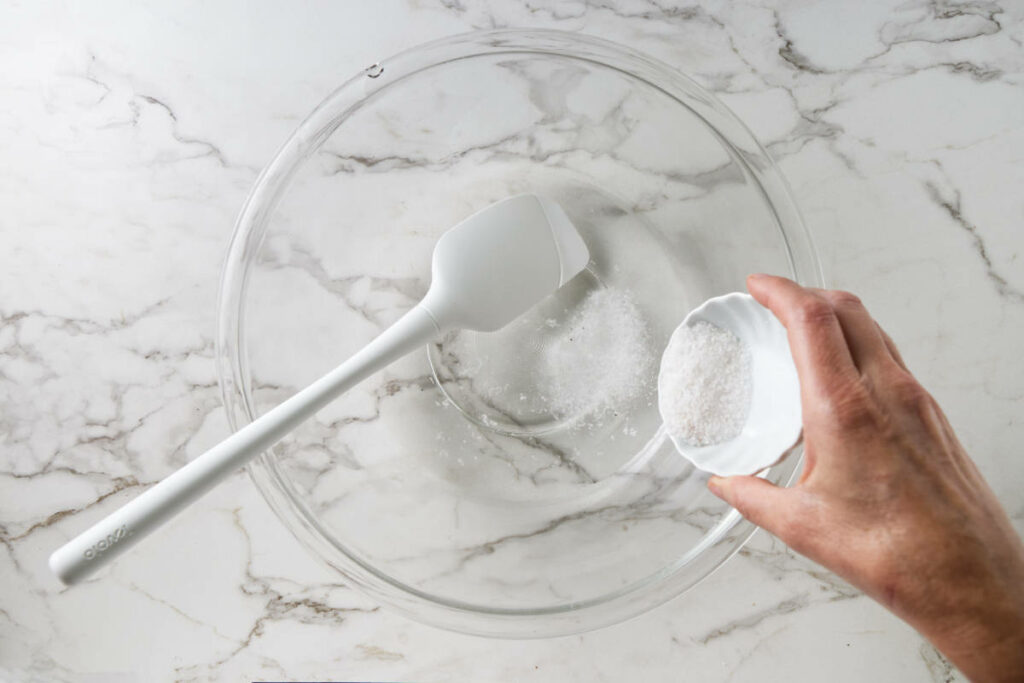
In a large bowl (or bowl of a stand mixer) mix the water and salt. Stir until the salt dissolves.
Note: This Neopolitan recipe may seem a little backwards to American recipes that add the salt last, but it ensures that the salt gets thouroughly dissolved.
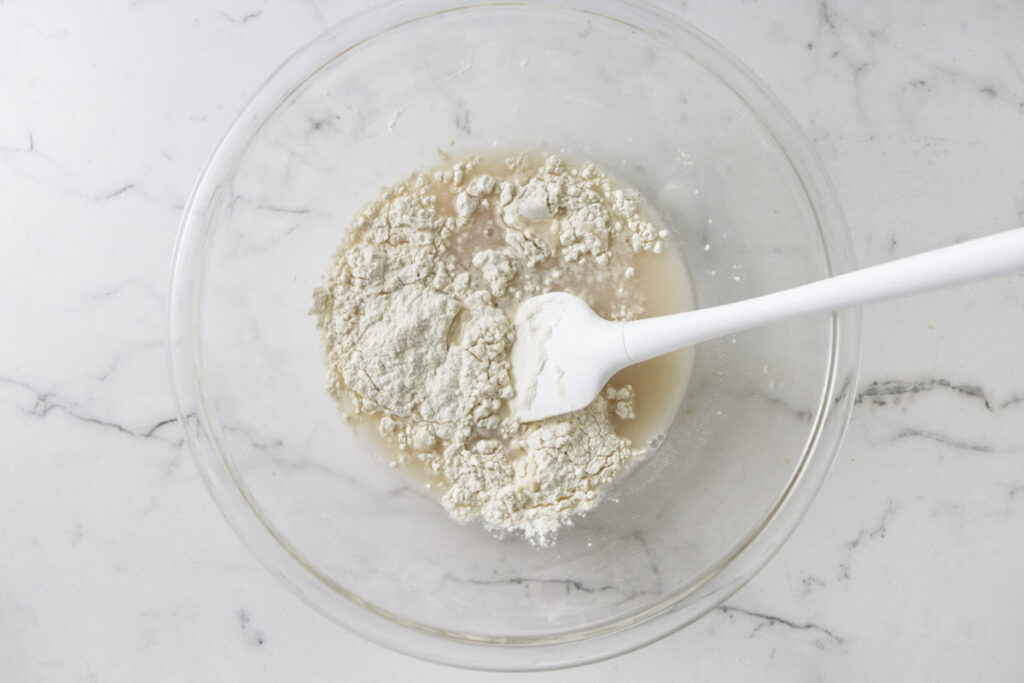
Add some flour- only about 1 to 1-1/2 cups. The batter will resemble a thin crepe batter at this point. Adding a little flour will protect the yeast from a harsh, salty environment
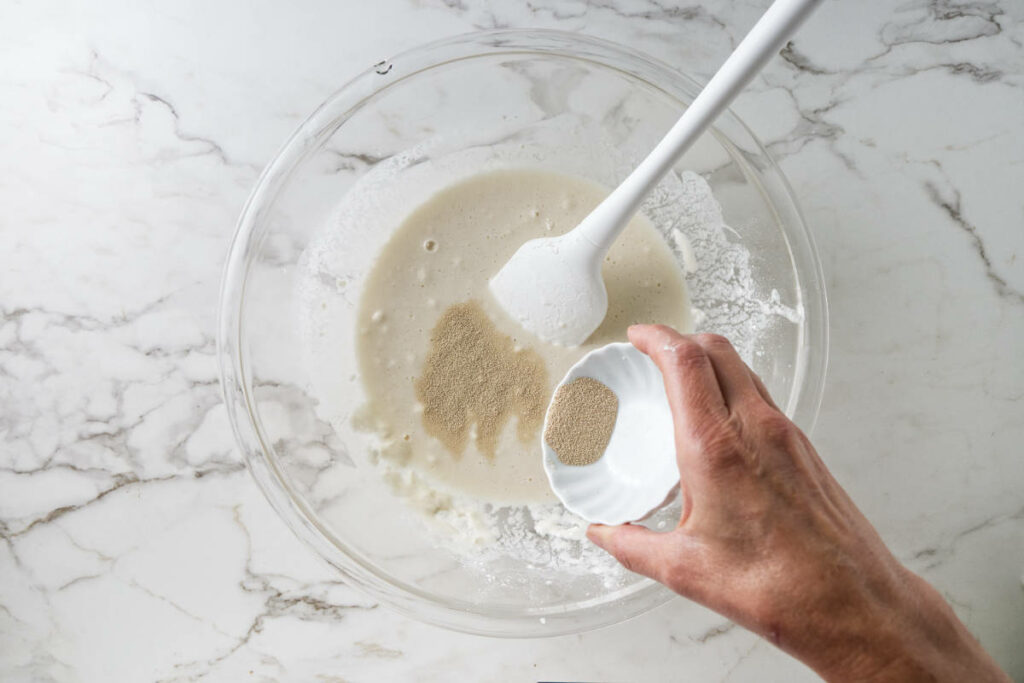
Mix in the yeast.
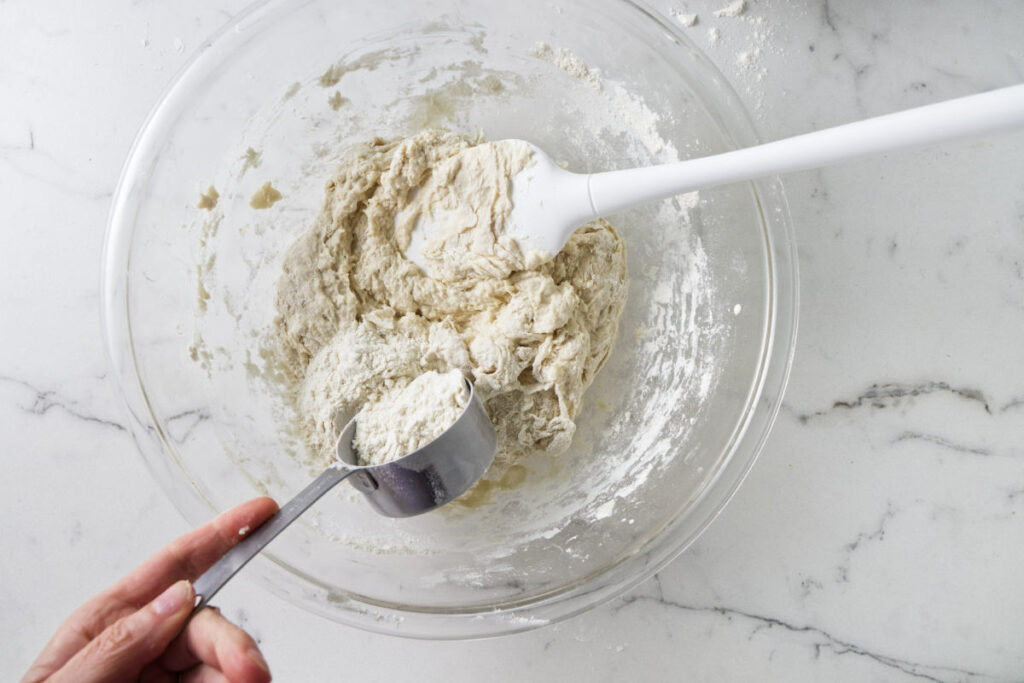
Gradually stir in the rest of the flour.
Tip: Adding the flour slowly gives it time to absorb the water. If there is any flour that does not get incorporated, you can knead it into the dough in the next step.
Knead, Ferment and Make Pizza
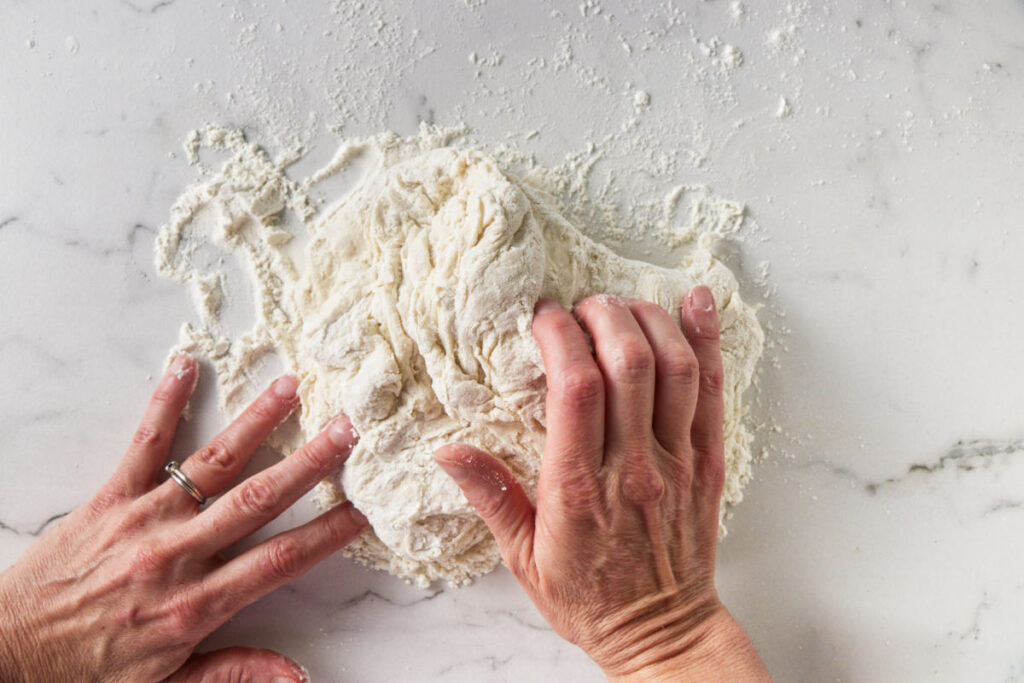
Knead the dough until smooth on a lightly floured surface (or use the dough hook attachment for your stand mixer).
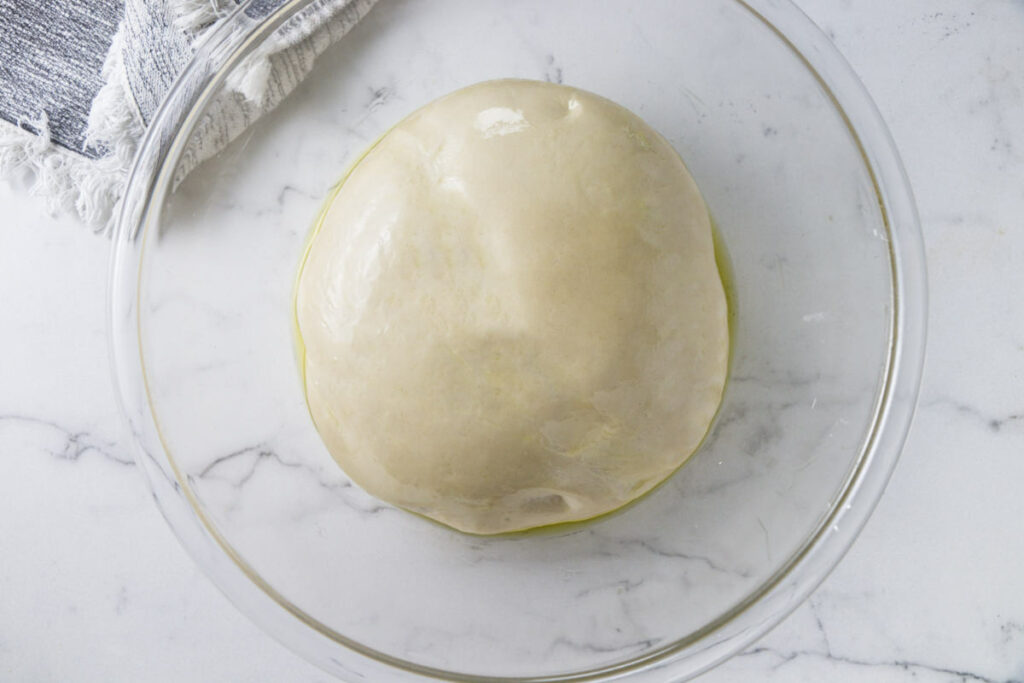
Place the dough in an oiled bowl and cover it with a damp towel. Let it rest in a warm place for 2-4 hours.
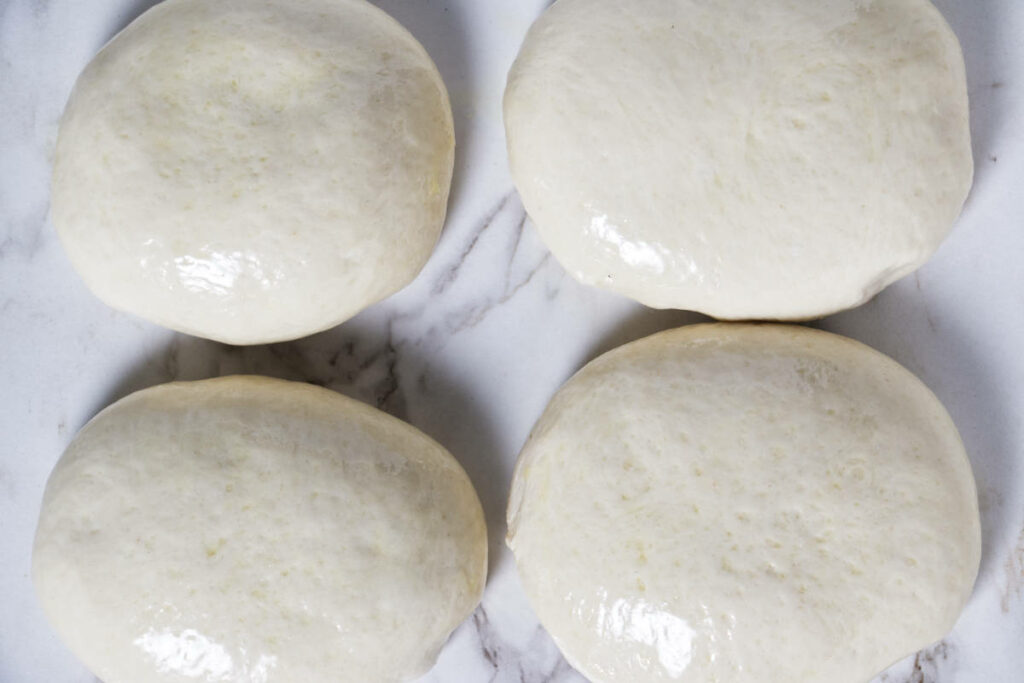
Divide the dough into 2-4 equal pieces and shape each into a ball. Place them on a tray and coat them in a bit of olive oil, then cover with plastic wrap or cling film and let them sit at room temperature until doubled in size.
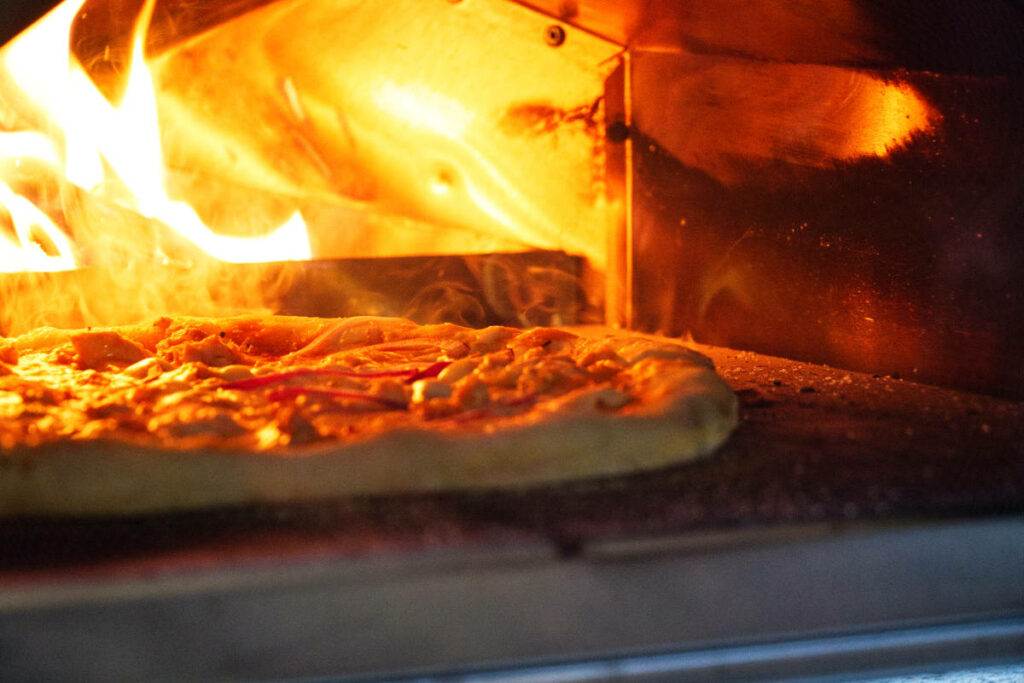
Stretch out the dough, top your pizza and slide it into the pizza oven!
Tip: If your oven has a pizza stone, bake it on that. It will only need 1-2 minutes when baking at 700° to 900°F. Turn it every 20 to 30 seconds to make sure it’s cooking evenly.
Not Just for The Ooni Pizza Oven
This recipe works with any high heat outdoor pizza oven. We have an Ooni pizza oven, but there are other pizza oven brands that cook hot and fast. That is what this low hydration dough recipe is made for.
More Artisan Bread Recipes
- Greek Easter Bread (Tsoureki)
- Beer Pretzel Bites
- Navajo Fry Bread (Two Ways!)
- Einkorn Naan with Garlic and Onion
- 21 Artisan Bread Recipes
Recipe Tips For The Best Ooni Pizza Dough
- If you’d like a slow ferment for the dough, you can place the dough in the refrigerator for its first rise. Let it rise for 24 to 72 hours. The longer it ferments, the better the flavor!
- 00 flour absorbs liquid differently than all-purpose flour. If using all-purpose flour, adjust the ratio to get the right consistency for a pizza oven.
- If you’d like to make sure your dough portions are equal in size, you can pull out a kitchen scale and weigh them.
- The small bit of olive oil on the dough prevents it from forming a dry skin on top when proofing.
- Neapolitan pizza dough usually calls for fresh yeast which is not as common of an ingredient in most American kitchens. We adapted this recipe to use instant dry yeast instead but you can still use fresh yeast if you double the total amount.
- Compared to American-style pizza dough, you’ll use a pinch more salt for this Ooni pizza dough recipe. The salt helps form a stronger gluten network and adds to the crusts’ deep flavor. Plus, it gives the pizza crust that authentic texture that you get from the best pizzerias.

Homemade pizza has never been better! This Ooni pizza dough recipe uses all the tricks and tips you’ll find at your favorite pizza joint.
Whether you’re making homemade pizza for the first time or you’re a seasoned pro, this simple recipe will not serve you wrong!
Helpful Tools
Some of the following are affiliate links. If you click on these links and purchase something, we may receive a small commission. You don’t pay any extra, but it will help us keep the lights on.
Some More Recipes You Will Love:
Sourdough Pizza Dough is the perfect crust if you have a sourdough starter on hand! You can easily make this in your home oven and the taste of the crust is unmatched. If you’re looking to level up your pizza game, this sourdough pizza crust recipe is it!
Buffalo Chicken Pizza is one of those classic pizza flavors that we revisit again and again. Spicy homemade buffalo sauce, tender shredded chicken and three types of cheese come together to create one of our favorite tasty pizzas!
Our White Garlic Sauce for pizza is creamy and flavorful! It goes with a variety of pizza toppings and is also versatile enough to use in soups, pasta and even with veggies.
Pin this now to find it later!
Pin It
Ooni Pizza Dough (For Pizza Ovens)
If you make this recipe, please leave a star rating and comment.
Ingredients
- 1⅔ cups water, warm (100°F); 394 grams
- 3 teaspoons salt, 18 grams
- 5⅓ cups Tipo 00 flour, 640 grams or 680 grams All-purpose flour
- 2 teaspoons instant dry yeast, 6 grams
Instructions
- Before you begin, if you want to do a slow ferment to develop more flavor in the dough, decrease the yeast to 0.75 grams or 1/4 teaspoon. The smaller amount of yeast will allow you to ferment the dough for up to 72 hours and develop more flavor.
Mix the Dough:
- Add the water to a large mixing bowl (or use the bowl of a stand mixer) and stir in the salt until it dissolves.
- Stir in approximately 1 to 1-1/2 cups of flour. It will look like a thin crepe batter at this point. (The small amount of flour provides a buffer between the salt and the yeast).
- Stir in the yeast (if you plan to cold ferment the dough for 72 hours, reduce the yeast to 1/4 teaspoon or 0.75 grams).
- Gradually add the rest of the flour in 1/2 to 1 cup increments. Stir well between additions. Adding the flour slowly gives it time to absorb the water. If there is any flour that does not get incorporated, you can knead it into the dough in the next step.
Knead the Dough:
- Transfer the dough to the countertop and knead until smooth (or use a stand mixer). The dough will seem dry at first but it will start to come together as you knead it. It will take about 10 to 20 minutes to knead the dough until it gets to a smooth consistency. If the dough seems sticky, dust the countertop with some flour.
Bulk Ferment the Dough:
- Place the dough in an oiled bowl and cover it with a damp towel.
- Let the dough rest in a warm, dry area for 2 to 4 hours (or in the fridge for 24 to 72 hours if you want to do a slow ferment).
Divide and Proof the Dough:
- Divide the dough into 2 to 4 equal portions and shape each portion into a round ball.
- Place the dough balls on a tray. Coat them in a thin film of olive oil and cover them with plastic wrap. Let them sit at room temperature for 2 to 4 hours or until doubled in size.
- At this point, you can either make your pizzas, or freeze the dough balls for up to three months.
Make the Pizza:
- To make pizza, place each dough ball on a floured surface and use your fingers to push and stretch the dough into pizza rounds (or any shape you want).
- Top the dough with toppings of choice and transfer it to a lightly floured pizza peel.
- Make sure the pizza moves freely on the pizza peel when you shake it back and forth. If it doesn’t move freely, lift the edges and add a dusting of flour under the pizza or lift the edge and blow a puff of air under the pizza.
- Slide the pizza into the Ooni pizza oven (or other outdoor pizza oven) and bake at 700° to 900°F for 1 to 2 minutes. Turn the pizza ever 20 to 30 seconds to ensure it cooks evenly.
Notes
- 00 flour absorbs less liquid than all-purpose flour. If you use all-purpose flour, you will need a bit more flour (or less water) to get the right consistency for a pizza oven.
- When you proof the dough, coat it with a bit of oil so it doesn’t form a dry skin on the top.
- If you freeze the dough, let it thaw overnight in the refrigerator then remove it from the fridge 2 to 3 hours before making the pizza.
- Neapolitan pizza dough typically uses fresh yeast. Since most American kitchens don’t use fresh yeast, we adapted the recipe for instant dry yeast (you can use fresh yeast if you double the amount).
- There is a pinch more salt in this recipe compared to an American-style pizza dough. The salt helps develop a stronger gluten network and deep flavor. It gives the pizza crust that authentic texture that you get from the best pizzerias.
- This recipe makes four 12-inch pizzas.
Nutrition
Nutrition information is automatically calculated, so should only be used as an approximation.
 Like this recipe? Rate & comment below!
Like this recipe? Rate & comment below!


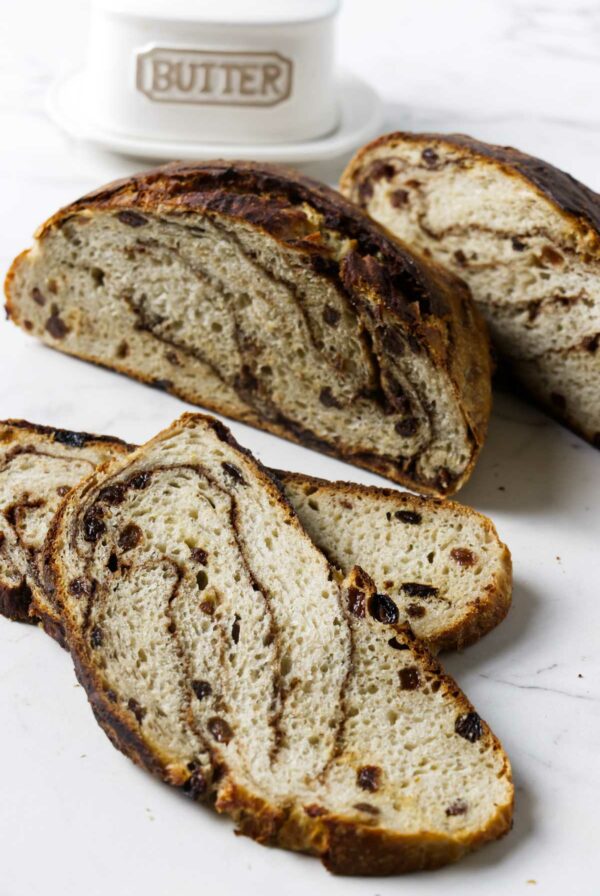
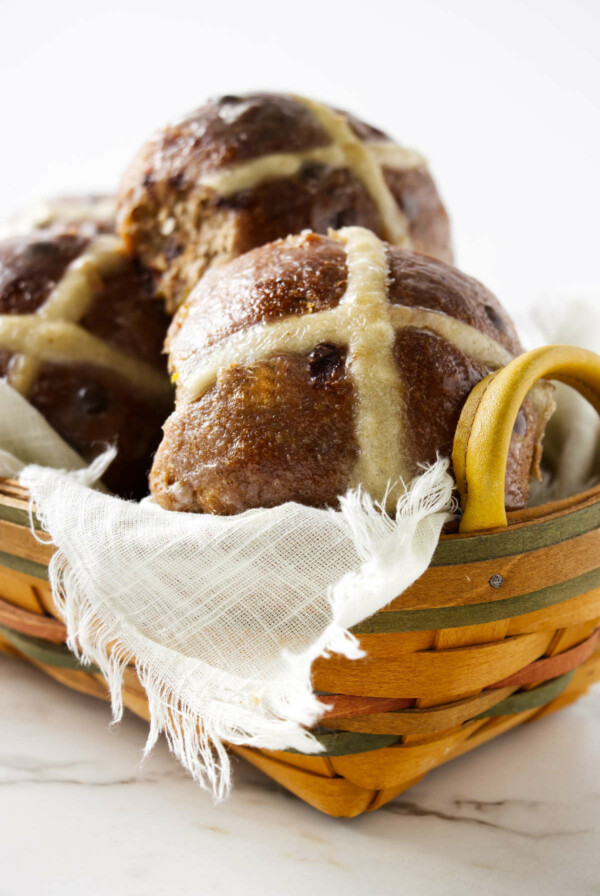
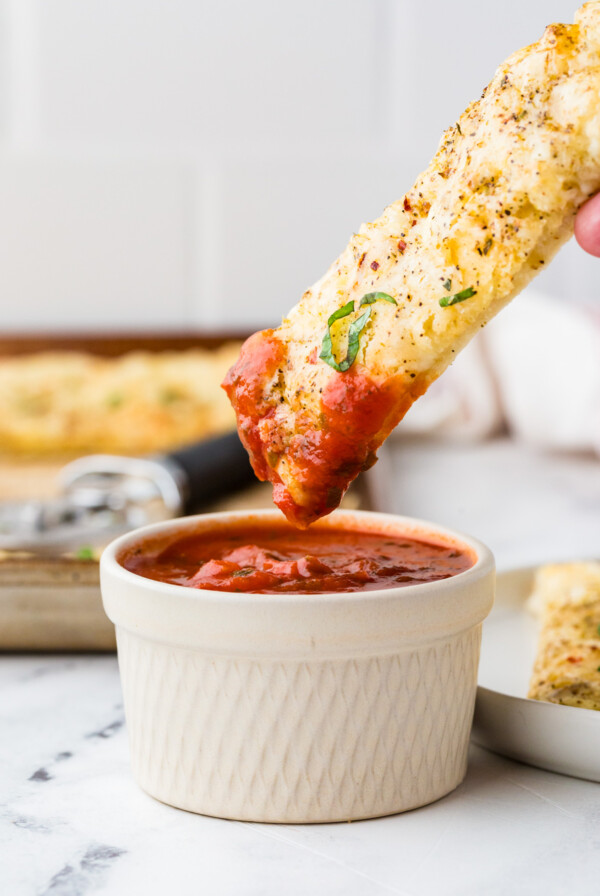










Hi Dahn,
How long to knead dough with mixer & dough hook? Do you cover & wait before putting in fridge.
Thanks
You can knead the dough with a stand mixer and dough hook for about 8 to 10 minutes on medium-low speed until it becomes smooth and elastic.
As for refrigeration, cover the dough and let it rest before putting it in the fridge. After kneading, place it in an oiled bowl, cover it with a damp towel or plastic wrap, and let it sit at room temperature for about 30 minutes to an hour before transferring it to the fridge for cold fermentation. This helps kickstart gluten development and fermentation. Thanks for the question.